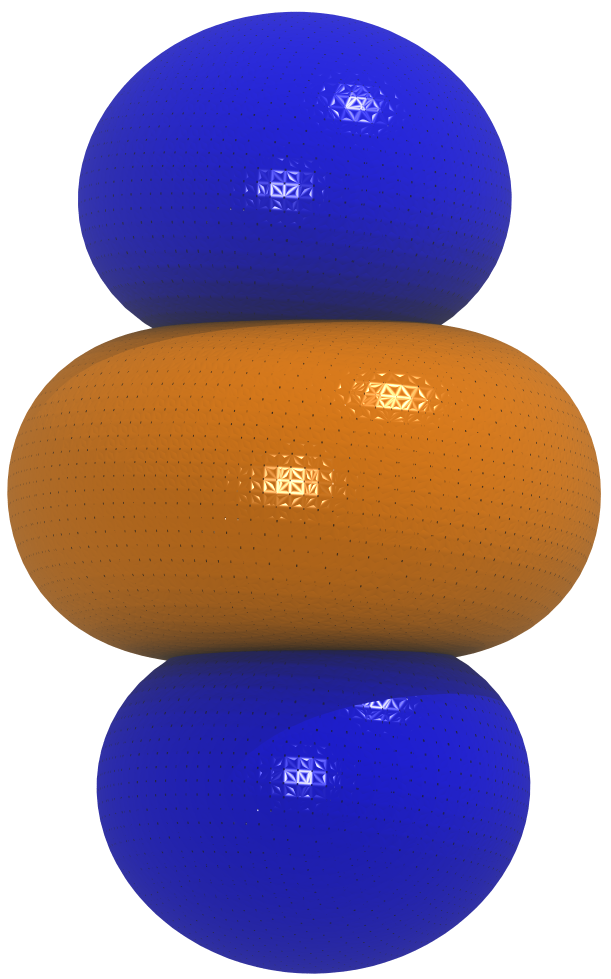Loading orbitals from NAMD QM/MM calculations in VMD
In quantum chemistry ab initio or DFT methods, molecular orbitals (MOs) are expressed in a discrete basis set expansion of Gaussian-type orbitals (GTOs). The GTOs are given by the basis set definition, where multiple GTOs are contracted to a single GTO basis function.
To extend the analysis capabilities for the QM/MM suite and its supported QM packages, we implemented a molfile plugin that is able to load the orbital information from both ORCA and MOPAC. The plugin is able to read a plethora of job types, such as single point calculations, geometry optimizations, and gradient calculations. Trajectories can be viewed by loading the appended output files for energy and gradient calculations performed by either ORCA or MOPAC during the QM/MM simulation without any workaround.
Orbital Visualization Step-by-Step
Oxygen Molecule
Our first example is an oxygen molecule. We created simple .pdb and .psf files by hand, letting the two oxygen atoms 2 Å apart. Using NAMD/ORCA we performed 20 steps of minimization and 100 steps of MD. Both oxygen atoms are treated with quantum mechanics, using the MP2 method and a triple-zeta basis set.
All necessary files to reproduce and analyze this simulation are found here.
To visualize the molecular orbitals, unzip the file (tar xfz O2orbitals.tgz) and follow the steps:
- Navigate to the unziped folder
- Start VMD - Use always the most recent version from here
- Go to: VMD Main > File > New Molecule
- Browse for the appended ORCA output: O2.out.orc
- Determine file type: Orca
- Hit Load
Because initially the two oxygen atoms are too far apart for VMD to draw a line connecting them, nothing will be shown in the VMD OpenGL Display. To visualize the atoms and the orbitals follow:
- Go to: VMD Main > Graphics > Representations
- Change Drawing Method to: VDW
- Change the Sphere Scale to: 0.2
- Because there are only 2 atoms, and the viewpoint will be very close to them, you might want to increase the Sphere Resolution to anything larger than 50
- Hit Create Rep
- Change Drawing Method to: Orbital
- To represent the highest occupied molecular orbital (HOMO), change the Orbital to 8
To show both + and - terms of the molecular orbital wave function:
- Hit Create Rep
- Change Drawing Method to: Orbital
- To represent the highest occupied molecular orbital (HOMO), change the Orbital to 8
- Change the Isovalue to -0.05
Using NAMD/ORCA Loading Script
For larger systems the Graphical Representation window of VMD might get complicated to use. In a first step to create a whole new Orbital Visulization plugin in VMD we created a .tcl tool that guides the selection of the orbital speeding up the process of loading and visualizing the molecular orbitals. To use it, download the script and follow the steps in a fresh VMD (not the one you were using in the previous steps).
- Navigate to the unziped folder
- Start VMD - Use always the most recent version from here
- Go to: VMD Main > Extensions > Tk Console
- In the Tk Console type: source complete-path-to-orcaviewer.tcl
- In the OrcaViewer window go to: File > Load
- Browse for the appended ORCA output: O2.out.orc
- Hit Open
- Select an Orbital to be visualized, e.g., HOMO
- In this particular case you might want to also go to: VMD Main > Graphics > Representations
- Change Drawing Method of the first selection from lines to VDW
- Change the Sphere Scale to: 0.2
- Because there are only 2 atoms, and the viewpoint will be very close to them, you might want to increase the Sphere Resolution to anything larger than 50
Molecular Orbital Representation





